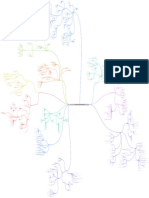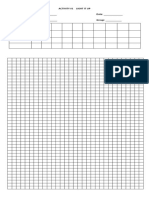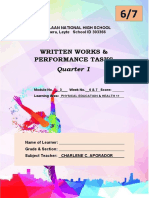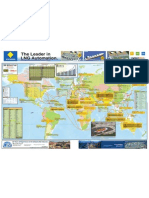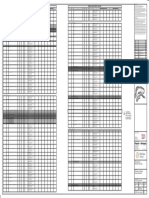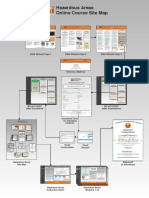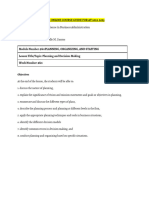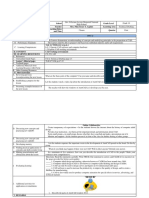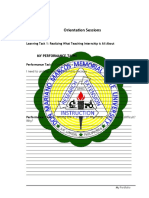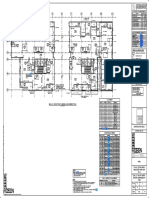0 ratings0% found this document useful (0 votes)
55 views80 pagesE-Tutorial Handout
ods 3
Uploaded by
mimlimonCopyright
© © All Rights Reserved
We take content rights seriously. If you suspect this is your content, claim it here.
Available Formats
Download as PDF or read online on Scribd
0 ratings0% found this document useful (0 votes)
55 views80 pagesE-Tutorial Handout
ods 3
Uploaded by
mimlimonCopyright
© © All Rights Reserved
We take content rights seriously. If you suspect this is your content, claim it here.
Available Formats
Download as PDF or read online on Scribd
You are on page 1/ 80
[E-tutorial on Mainstreaming the 2030 Agenda for Sustainable Development]
SUSTAINABLE
DEVELOPMENT
Mainstreaming the 2030 Agenda
for Sustainable Development
(Rana nitar
SS) Main Menu eer
Mainstreaming the 2030 Agenda
for Sustainable Development
@Oumewes O| Punitar
Introduction
co) era.
The 2030 Agenda for
Sustainable Development
A, context
a 2. agenda structure
ee rated
o 3. Mainstreaming Guidance
co) era.
Ata UN Summit (25.27 Sept
Member States ofthe United Nations
adopted “The 2030 Agenda for
Sustainable Development with @ set
Of Sustainable Development Goals
(S0Gs) t ts core
i offcially came into effect upon expiry of the Milennium Development
Goals (MDGs) on * January 2076, wil run through 2030 and applies to
every country
The 2030 Agenda for Sustainable Development:
« |S just,ights-basee, equitable and Inclushe (Leaving no one behind;
- requires an integrated approach to sustainable development anc
in a manner consistent with existing obligations of
tates under international law.
<¢ Plen of Action is structured in four main perts:
(Click on each tab to learn more)
2. agenda
Structure
®
The Vision ond Principles are outined in detail
in the Declaration and include areas of critical
importance for humanity and the planet
encompassing People, Planet, Prosperity,
Peace and Partnership (5?)
The 2030 Agenda for Sustainable Develooment seeks to realize
human rights of all (Preamble) ang is grounded inthe UN Charter, the
Universal Declaration of Human Rights, international human rights
treaties and other instruments,
The Declaration further describes that nations are.
jashed mee the Huan race tor te Oran of
esta reoten sears or pine Wee dtarmen he eA a
iroeformee Ss ich are gery needed to Sth Word ort 8
donaruse ts eer pals fe ne ert an bie come ou Ne
2. agenda °
Structure
verry and want
) rere ria
The results fremenork inclu
169 targets.
The SDGs seek to buld on che Millennium
Development Goals and complete what these
did rot achieve. Additionaly, the SOGs are
‘integrated and indlvsible and talance the
3 dimensions of sustainable development:
Furthermore, the SDGs sre universally applicable, coking Into
accourt diferent national reslties, cepacites and levels of
development and respecting national policies and priorities. Thus,
each government wil decide how the targets of SDGs should be
incorporated in national planning crocesses, policies and strategies.
2. agenda
Structure
) rere ria
®
In the spirit of continuous improvement and
CONC EU SENN accountability, nations commit to fully engage
Ce in conducting regular and inclusive reviews
of progress at: “sub-national - notional - regional
slooallevels*
National reports will allow assessments of
progress, Identify challenges and inform
recommendations for follow-up at both the
regional and global level
is 8 global indicator framework outining 2 oraciesl set of
Inclcetors t0 suppor: the Folow-up and Review of the SDGs. The
framework and ingietors, created by the Inter-Agency and Expert
Group on SDG Ineceors, have been agreed by the UN Statist
Commision March 2016 and have been adopted thereafter by the
2. agenda Economic ard Social Courcl and the General Assembly, in line with
Suc ‘existing mandates,
introduction — 2. Agenda Str
Through the 2030 Agenda for Sustainable
Development. nations acknowledge the
DTU | incercive cfs revitalized global partnership
~ "an intensive global engegement in support
cof implementation of al the goals and tergets
bringing together Governments, cl society, the
‘private sector, the United Notions
system ond other actors and mobilzing al
availble resources
The scale and ambition of the new Agenda
require the inclusion of new partners such se
+ national perlements,
+ regional and lacal authorties,
+ acaderia
+ volunteer groups.
2. agenda Si iporean ie the rian Of tnglarientatn ts the Ageia that e
SERIE | torre the besator $00 17 ord te supporing trp.
int Nees
How can we implement the 2030
‘Agenda and tatlor the SDs 10
rational contexts?
Drag-and-drop each area of
mainstreaming according to the
process and timeline it belongs to.
Drag.and-crop these tabs on the table.
Pian eed
Please be advised that the
timeline of steps can be
differentiated depending on
‘countries’ own circumstances, erry
Thistable is intended to show [oar
dynamicand mutual influenc eres
ofa ores —, Pore
Main Guidance
ieee
1. Building
Awarenere
°
°
The 2030 Agenda for SUSTAINABLE
Sustainable Development GOALS
Purpose
Building public awareness and engaging national, sub-
national and local stakeholders in the 2030 agenda for
Sustainable Develogment and SDGs is @ criical intial and
ongong step in successful implementation, Beyond
awareness, achieving a similar level of understerding
among governmental and non-governmental stakeholders
' crcl. This means reaching out to ali leves and sectors
ith information that Is talored to therr spectic ‘unctons,
roles, and responsitities.
A clear understanding of the benefts of aligning national and sub-national plans
and policy-making processes with the 2030 Agenda and SOGS as well 35
building ownership for t among people, Inclucng the marginalized. provides
the foundation for is real and lasting delvery
This step can enharce the impact of all other guidance areas in tis tutor
and utimately, the impac of the Agenda Itself Given that the SOGs are a globs
Agenda, itis critical to support national audiences in linking them to local
concerns, thus helpng to ensure sustainable publc suppor for the SDGs.
CCN resem PEC
Guidance
What strategies can be applied to build awareness?
1. Introductory Workshop Series
‘government officals and stakeholders te the 2030 Agenda and
2. Public Awareness Campaign
to communicate new Agend
and youth,
general public, including women, chilren
3. Opportunity Management
10 leverage other meetings and forums:
ieke me
(+) and stakeholders to the new Agends,
sensitise government officials
1. Building
Awareness
CCN resem PEC
1. Introductory Workshop Series
The United Nations Institute for Training and
Research (UNITAR) has presered “a self-
explanatory integrated toolkit” designed to
support national faciitators in planning and
delivering briefings at the country level: UNITAR
Post-2015 Notional Briefings
This package consists of @ series of Interactive workshop training
oe modules. itis ideal for sensitzing national government offidals and
() staleholdersto the 2030 Agenda and SOGs
Link bse: povergti
1. Building 4
ce pa
f=) Guidance ~ 1. Building Awareness
UNIIAK's National Post-201> Development Agenda Briefing Package in Uganda
‘The Ugenden goverrment was the frstin piloting this brieing
package in Kampele, together with the UN County Tesm end two
training experts ‘rom UNITAR. The event un‘olded over two days
‘ard wes led by the government end fscliteted by representa
from the Ministry of Foreign Af =, Pl
ard Economic Development; end the Nstional Planning Authority.
ing
ing: the Ministry Fir
Experts rom UNDP and the UN Depsrtrent of Economic and Socis| ffsirs (DESA) also
contributed to fecitation by presentng ¢ global perspective on the ewlving asues of global
partnership, Snancing for development, review, followup, and SDG synergies
The exercise highlighted how the government of Uganda has already made significant
progress in integrating the proposed SDGs into national planning. Spec ely, he proposed
Natonel Development Plan Il (NDPIl) elresdy indudes many of the SDGsenda signficert portion
‘the proposed targets have been adjus
—) RE eee metered orient
2, Public Awareness Campaign on the 2030 Agenda and SDGs
The mass outreach and marketing of sustainable development concepts
and agendas are important While sustainable development has entered
the vocabulary of experts and the interested public, the terminclogy and
concept has yet to fully permeate the general public and
discourse.
Given todays Internet and social media platforms, combined with
traditional media (i.e, TV, Radio, newsprint, as well a5 the outreach
capacity of cil society organizations and volunteer groups, there are
‘more avenues than ever to reach the general public. These are particularly
ines relevant to reach younger audiences, whose members will be both key
decors aswel as the nerters ofthe world the SOGs seek tocreste
1. Building
sens RE
SS Guidance — 1. Building Awareness
I rite scioemonoseme en e
Global Outreach Campaign: “Project Everyone”
Ase globel outreach campsign for the 2030 Agenda, Project
Everyore indudes mutiple traditional and social media
0 reach a maximum number of people.
uld be emulated at s national level, with an
bjactive "to reach eveny ctizen’in the country ta share
information about the existing or forthcoming national plen
‘and how it will endeavour to integrated the SDGs et the
rational level and how sub-n:
ld follow suit
A key dlement of this campaign project is bulding ewareness ofthe worlds youth, For
example, The Worlds Lorgest Lesson is designed to be the bggest ever colatorative
education project imiting tes hers from around the worldto submé: excting lesson plans,
with the winning idees publichad ars globsl cet of learning resources on te webste, to
erabletescrersto crate relevantlesson on the SDGs for the children thet they teach
Link pp nwnoroe enone!
—) RE eee metered orient
3. Opportunity Management
Other forms of engagement cen be leveraged to sensitize government
officials and to raise public ewareness that are perhaps less formal (and
less costly), but can also be effective and ouilton existing channels,
These opportunities could inclu
+ dedicated sessions on the $DGs at donor coordination meetings
+ press briefings or meetings with the press (on and off the record)
+ UNewide town hall meetings,
ne + opinion plecesin the local press
s + the use of existing social media tools (e.g, Twitter, Facebook’
() + motile phone messaging
1. Building
|
f=) Guidance ~ 1. Building Awareness
a
U-Keport Initiative Keaching millions of People (UNICEF)
eport UNICEF groundbreaking text-message based innovation thst amples the vo
reves, hae reached | rulion acthe users.
ard
‘skis they way
‘vormaton is instantly mapped and analyzed y£\9rg \tsl
rformaton and real-time insights about row young peorie
ther world ara what they think is mest important. Inturn th
SgEegstEd Views sre sed by deisiopment panrers inthe!
with g
“URepor is an entirely new ‘engaging young people, empowering communities, and
holding governments more accountable’ s30 Je: Gough. UNICEF Repres
the putform is helping UNICEF workers share critical information ateut £2015
livingin remote areas that neath
Purpose
TheDiologues coll for government
1 srengren prope! best eoltcol rights oa a0 Oe
ate beter poicies ond generate better development extcones
As evidenced by the quotation above, central to the
legitimacy and qualiy of a socety-wide agenda is the
ieee g design of multi-stakeholder policy development
‘and implementation modalities in that cases, UN Country Teams ¢¢
(+) @ OQ” tow wo ‘exer the cevelopme
stakeholder groups, where necess
2. applying
sete
coe
rai up an oforrtion anon on Onporunts anaproceses Sr
reimplereraian af repos: 2015 9ger30 ne BI key proposal of:re for
‘007 = teestablich a regular platformorforumforthe EU sustainable development
agenca”
Cette eee Ti keholder Approaches for SDG Integration
InnovativeCese | 2 Workinewith National Multistakeholder Bodies or Forums ®
Somalia - Development and Implementation of a Compact under the Framework of
‘New Deal for Engagement in Fragile States’
In 2072 witnene
President 2 nina:
‘ppertunty for a new phase of stabilization and peacebuilding in Somalia
\was presentea. In oraer tne reaeral &
(FES), with cil society, pariament an stakenolders, and the internat
60 10 develop a Compact. guded by the principles of he New Deal
21) Pariament and selection of ne
‘As part or tne Compact whicn was proaucea on tne oasis or ragicy assessment the FGS and
international community defined mutual roles and responsibilities nc ware
archtecure and eal framework for advancing peacebulcing and
Somaia The compact was the result of an inclusive process and strong partnershio between the
FGS, the United Nations, the World Bank, EU and donors and other key partners. “ne FGSara
partners made sure there uae strongalignment between interns
Compact priorities and partnership prncipes. With suppor from the UN.the government established
rater Unt
an Ad Ci
link pl
i) Ea ear ese Cure eee eee ER elt
THE IN
CREATES CHANGE BY.
omental puting countries Inte lead a ne own pre et tty
| marta arson ot
elon wenn tapas ancconieaeced
caaesraeRe eam Building mutual rust avons orn,
oo One WO 8 w ONE PAE
JUSTICE - Address inpotices 6 ncranie Stemcavig Os OF COUNTRY EYETEUS misting
corn peers ea
ee ponte — QIMELY 6 PREDICTABLE AID orougn
= Guidanc ENN 2 A Teed ele
3. Guidance on Multistakeholder Dialogue
Some countries may already be poised for deeser
Gialogue cn the integration of the SOGs (eg, about
to engage in 2 national vsioning process). In such
cases, guidance on how to conduct large-scale
multistakeholder dialogues willbe rove use!
15 "Word We Wore Global Conversation inated in 2012,
‘the UNDG issued guidelines to UN country teams for conducting national
oo Consurtatons, Tne ravonal clalogues were designes to “stimulate an inclusve,
ose bottom-up debate on a post-2015 development agenda in order to
complement the existing intergovernmental process.” In the context of the
dialogues, the guidelines provided “ideas for how to promote inclusive
consultatons with government representaties, NGOs, vil socety
community-based organizations (CBOs), indigenous peoples, women's and
social movements, youth and children, and the prvate sector, arong others.“
2. applying
‘Multi-stakehoider |
ite pa
+ Incision Etre enauis o# mace o-open the consultations to al stakeholdersinthe county
who wil be affectad by ine 2020 eras ar Suraratie Deeoprent
+ accountabllty: Evens srouie #20 be mae to ereure ne ceonie
consuiatiors have accesso relevant information and can prove feedbackand influence the
resultsand the process ofthe consultations. ers spectesly
sy kre of corsu
ed
keholder Approaches for SDG Integration
National Post-2015 Consultations Across Afr
In Arica, formulating long term and short term development plans have demanded troad consultatons
with dtfeent stakeholaers. sutatons included new forms of
t normaly particpatein
including wornen and youth groups.
th disap jing with HVAIDS, academia
anathe privat
Face-to-face meetings in verious formats dominated consultation methodologies in athe 30
Sn pane! intenvews and
2 \5€9,'n 20970F. on-and.ortine Surveys \
CMe Itect
eaeme
2. applying
‘Multi-stakeholder
Approaches
CY Nite Duo Eoeren ater
4. Fostering Public-Private Partnerships
Partnerships with the business sector wil’be 2 crucial part of implementing
0 Agena,
Businesses around the world have experience wth
a Integratng sustanable develooment and corcorste social
responsiblity (CSA) penciples Into panning and reporting
practices through the adoption of volunteer guidelines such
asmne ve te Coreon Oscosure Pro}
‘nd Greenhouse Gos Protocol UW Gicbol Comeace and ihe
Guiding Principles on Business ond Human Rights, just to
name afew
‘The innovativeness of the private sector can bring new insights to the
solution of systemic sustainable development issues anc the ubiqutous
nature of supply chans represents a leverage pont for scaling up the imoact of
sustainabilty recices. Combine with the investment potential of the private
sector in devng lecal, sub-national, national and global developmers, the
necessity of publicprvate partnerships fer irplerenting the 2030 Agenda is
ear. Given this context, Menber States with the suppor of UNCTS where
required can endeavor to nclude the private sector ‘as
inal stages of implementation,
000! Reporting ii t
[Sienicae
‘orsis. We callon all businesses to apply “their cezivity and
innovation” to solving sustainable development challenges,
agence for Sustains Dasicomeni(eore 8)
Cette eee Ti keholder Approaches for SDG Integration
Innovative Case 4 Fostering Public Private Partnerships
UNEP/GEF's en.Lighten — A Global Effi
i Lighting Partners!
iitstve s = public/private partnership bebe:
(SRAM and Philips Lighting with th
ae
China becare s partner in 2011 and the Austraian G
ntresin Asia and the Pace in 2013.
Test Centre
devel
Interested courtres rake 2 ded
ed pedge sgnaing the intent to work with enuighton to design
{and implement a set of policies and approaches that will enable the transition to energy-
‘efficient lighting quickly end cost-effectivel
Emonass is paced on an integrated approach fe
=) Guidance -3
The 17 Susoincble Onelogment Goo’ ond 169 carges which we are or
demonsiate the scale ard ombtion of this new universal Agerdo..They are
and indivisible ond oolonce the chree dimensions of susairable develogmert
‘economic socialare erviroamert
The 2020 Agendo or Sustainable Developer
Accordingto the 2030 Agendo, the SDGs and targets are aspirational and gobal
with each government caled to
a) decide how the SDGs should be incorporates in:o
‘onal plarningorocesses,poices and strategies
by set their own national targets gu\s20 0) tre gob)
level of ambition but taking Inte sccourt atonal
©) in the implementation of the agends build on
existing commitments and in accordance with
international human rights standards for che ful
Appropriate tools wil need to be developed to translate the international
rormative framework into practical instruments to support operatiors at the
rational level
ieee
3 adapting sos
‘to National Context:
—) Reine! DGs to National, Sub-national and L
Guidance
What strategies can be used to adapt SDGs to national, sub-national and
local contexts?
1. Reviewing existing strategies and plans and identifying areas for
change
1 Scan and detall te landscape of exsung straxegles and plans at the
national levels and then compere agains. the glotal SOGS and targets to
8805 and prove the basis for recommending areas for change.
2. Making initial recommendations to the leadership of the national
government
iesene {or adsressing $06 gaps in exsting strategies and olans whist recognising
thatthe 5063 ore ntegroed ond indvsble ond bolonce te three
dimensions of sustonebie cevecomert the ecoromic 0c) ond envronmento
3. Setting nationally relevant targets
dapted and inclusive SOGS that are achievable, yet amibitous.
4. Formulating strategy and plans using systems thinking
3. adapting soe to incorporate tne recommendations anc the insights from the above
teNationalContaxts Steps ino strategies and plans and matching ambition ard commitments
wh resources and canacites.
=) Guidance -3
1. Reviewing existing strategies and plans and identifying areas for change
This task
be manly viewed as a twasstep A and 8) process invalirg:
®n) scanninganc Detallingthe Lanclscape of Existing Strategies and Plans
8} Comparing Existing Goals and Targets with the Global SDGs and Targets.
‘Spectfic tools have also been created recently that can take the comparative
onabsis even further
SG Scorecard (developed byte UK-based Stekeholde-Ferur)
ieke me
* Sustainability Analysis Grid Tool
44 Québec aChicaain
bythe
sneside "Universté
AA} Scanning and Detailing the Land cape of Existing Strategies andl Plane
cay have ome form of nations ettegy er pian.
(work with UNCTS to review existing strategies and plans to
sting environmental
uld be bresdened te a
erty end eiminate impiementaion
sure that 10 goup “lef bend’. and
7 national and sub-national sas.
made to the countyy by UN’ Auman rights mechanisms
h as the UPR) re a valuable sources of information on the existing
ysis. Human rghts
dertiy which grougs are “beng let Bening.
+ National Leval-Longverm
ecumser oe
(NHR) /Povery
National svstegy for suaina
reunion ssey/ PRP) sora ovo aan
NesurTern Sipercture sna Frare
+ Subnational Level: De\eloorertpilan/ Sunnave ceveleprert
+ Local Levashunces
®
Merger of Development Plansin Belize
Intre procs ofzorsoeringfinve £06 m: oninelae
tnroign colabostior rrorgtre Goverrmant cf Selzer
UN DESH & UNDP 2recouney® Greve ang Bovey Resuecon Svony
‘has merged with ire in2r2i SUmainone Dae gener Sroueg)
‘one unified andcoherant strategy are sav"rg ect
srs Govtnond Suairane DestoarensSroney:
i) RES ae Tere cre Merona ome ola Es [hore Reece
8B) CemparinaiBxictina Goale and Tarot: with the Global SD¢ andl Taaets
Using mutistaveholder apprescher, Governments can undartste an ans}:
comparing the goals and targets and their outreach contsneo
of compatibility or conflict as well as any gaps n cortent as wel
rable grougs. Ths Could be core at 0¢
torgets agensed unger the 7 geez nore coumn anaec
dentiy the relzed the exsting penand x
gets are sigrea rerin
the case exanpes of Germany rand UNDPS new Rapdirtegrted
‘Assessment ool that was appliedin Bhutan Cato Verde Namibia and Tonga
3. adepting soGs
‘toNational Contexts
@
Inte seconc prasetne Rig crates a detailed at of recommendations with theinvolement of
Rapid integrated Assessment Policy Tool ®
20 riyplietes a prototype tool developed by UNDP
: nt Telos counries 0 gauge their readiness for DG
ied Foliy Sexes?
implerrentaton. Ts.
Sorscan ngacimutees SDs
(ressea nine 2020 gence, Identified gaps and possible oss-sectoralInkages
‘could be considered uselul entry prints for discussions on thefurthar elaboration of plans to
implement the 2020 Agenda.
i) RES ae Tere cre Merona ome ola Es [hore Reece
2 UK-nese0
* SDG Scorecard ( ole
The SDG Scorecerd can serve as 4 t20lto illuminatea national
conversation or consultation with stakeholders stout
ppicabity ofthe afferent als and targets in
ipementaton ststeges ard action plans srounc the highest priority
elements,
ables an expert to assess each gobal SDG target aginst
Imperentsaity, ana
3. adepting soGs
‘toNational Contexts
ESR We Tetra ce oN Cerone VIM omnes] Reread
* Sustainability Analysis Grid Tool evetonea 5 2he
qubbesé enue)
sip provice a common understanding of pectic goals,
andtargets, The cima agreement recchea a: tha 21s: Confrence of he
Paris (COPZ') of the Framasars Converion on Cimaw Changes one notable
saree Omer ecaroer on 2080 Framework for Acton
andthe Caio Deciaraticn on Gender?
uudethe Ea
3. adapting soGs
‘to National Contexts
Egucation 2030 Framework for Action
The Caro Declaration A Regional Commitment to Gender Equaty [M
=) Guidance-3. Ad
2. Making initial recommendations to the leadership of the national government]
With a revew in hand of how the goals of existing national strategies and plans
alreat any 220, government officials and
stakeholders can explore initial recommendations to oe delivered to the
leadership of thelr national governmert relating to how the comprehensive
scope of the SOGS across economic, social and environmental cimersions can
help teach long-term natonal development objectves and how existing national
5 could be sugrrent jppor the SOGs and targets.
This requires a good understanding of the current and evolvng poli
In respecuve countres by all sakenolde's
al process
The exploration and formulation of recommendations
delered to leadership should address not ony the
substantive issues relating to the need for new or
revised goals and targets, 2ut eso issues related to
the means of implementation.
eaeme
Given the complenty inherent in the task of making
recommendatons. for SDG integration, a multi-
stakeholder body or forum 5 uniguey able to
delver both the credibitty and leptimacy of a diverse
set of views ina umrely and cost-efective manner
erenpree mesrorame 20) and evironmansa” 2050 Agnao,erSustinaoe
Dereopment, whe wi rom
(oF2 comparison oF exsting national plan and the SOSS (icing alltnet arges)
sraigem provargsfauresionfereat maou
‘oualockng tne synergies of og ess acrcss 2! three dimensions of sistalnable
‘development «ith 2 22v.cJer/8 to having noone behind
@
Plamingirads, 25's sre seth err tche provision
sorortofine coumuy/sieo" 20 tre
Goverrmars of ugance ciscoverec¢
‘offered an intial Famework through which
‘dfferent sectors could trace ther linkazesto the
national priority areas. $0Gs were ircuces
\yin Crapier3cftne \DPlinat ae ou
1 corsator Ugnaa development
rere ofSDG targess was adjusted to national circumstances and
incorporate SD targets and inticators in « more detailed resutts framework 272
\ stent uergne Ste eeucere
po) RTE re ce
SDG Recommendations to the German Government
In 2015 the German Councifor Susinable Development (RNE)subminea As satementon German/s
Suminon)iyyarcrtecnr and me SDGr'0 the feos) go
170 om mars, place hover wer ach area
f=) Guidance — 3. Adapting SDGs to National, Sub-national and L
3. Setting nationally-relevant targets
At the global level, che SOGs and targets will be followed.up and reviewed usng a
Set of global indcatorsi- Meanwhile, the 2030 Agenda recognizes “that baseline
data for several ofthe targets remain unavailable" and cals for increased support
for strengthening data colecton and capacity building in Member States, to
develop national and global baselines where trey do net yet exis. And through
Tne 2030 agenda, Member States commit to addressing this gap in data
collection £9 2s «9 better inform the measurement of progress, in particular
‘for those targets below which co not have clear numerical targets.
In most situations, target setting isan involved process thats beth deliberative
and analytical +
ieke me
While national-ieve indicators can overlook varance at the sub-national and local
levels, based on people-centred and contextspectic, comprehensive and
prevertion-crierted princbles, the human security approach provides a set of
taols to gather data on peoples actual needs vulrerabiities and capacties th
Is disaggregated by regi, gender, ethric identity and religion, among others.
The approach has led to inclusive and participatory processes which have
B adapting soc _‘evealed gaps in existing strategies and mismatches Desween lacs reeves
and national policies and progremmes 3
‘to National Context:
‘The gobalindietor framework
aging ono peterpan 90 nacero7 a Vercnacieere
Ecqromicene S0c' Coun ane ne Gerersiasserby, 7"
* ThrsholicTrevaue of
loge Framework forthe proces
aromissin for Euroee aro
PEMOUTE Ne ere Kec
Human Security in Theory and Practice
househcld survey greatly expandad the understanding ofthe challenges feced by communities in
differen: regions to compliment the quantitativedata
news t proviges scctiona information or
=) Guidance -3
4, Formulating strategy and plans using systems thinking
alengingtaskof
elevant SDG gap recommendations
the navonal development alan and surporing
sector plans. Every Member teas in place ther own
procedures for creating a national strategy or plan, and
‘hese shouldbe the focus for implementingSOG
emendstiors, Member Stites could begin
Indicators > Systems > nnovaton> Suotegy-Ackisson 2010) andas pert ofthis process insights on
key cause-and-effect linkages emerged yielding important policy linkages across
immigration, health and environmental issues.
Aastonaly the Belize government
‘multifactor analyss tool tohelp prioritize
‘actions that nave the greatest potentis for
f=) Guidance — 4. Creating Hor Coherence (breaking the sil
Purpose
“The chalienges ond cemmitmentscontinedin these major cenfererces ond summits
inerelotes onal for insgratee soluions Te aoaress them efecevey. 2 nen ager
isreeded. Sustainable develoomertrecegriaesthoterodicatingpovery inl its forms ond
dimensions comoaring insqua
creotng sustoired. incusie ond susainable economic growth ond fostering. social
incuson ov nied toe0ch ether and ore itersependent
The 2030 Ager for Su
noble Developme 5)
weet As the 2030 Agenda cals for miegated solitons
‘loving ave neeceo fo the mplemersation
2 creing otaora pole coherence, integration and
parterstips
4. creating ‘They are relevant to all levels of govemance: nationa,
Horizontal subnatal an oc
Policy Coherence
Coherence (breaking the sil
Creating Hor
— eis
Guidance
What strategies ean be applied to create horizontal policy coherence ?
1. Integrated policy analysis
10 ensure that proposed polices, programmes and targets ar
of natonall-adepted SDGs.
supportive
2. Coordinated institutional mechanisms
to eraate formal partnerships across sectoral line ministries and agencies
3. Integrated modeling
to help Canty and articulate the interconnected system of goals and targets
programs and project for their
ieke me
(4) impact on nationally-adapted SOGs
and te ana)se and inform key policies
4. creating
Horizontal
Policy Coherence
=) Guidance — 4. Creating Horizontal Policy Coherence (breaking t
1.Integrated policy analysis
With an approzch of integrated policy analysis, Member States could screen
policy and programme proposals for ther potential to elther bene!
negatively mpact on spectc national Issues of concern. I: then ideally asks (
policy revisions before they can be submitted to cabinet for approval +
Another integrated analysis tool is the Framework for Cooperation for the
systemwide application of Human Security (=amewor. for Cosperstio
developed by the inter-Agency Working Group on Human Security.
1 offers an anaitical ramework that atvances comprehersive and integrated
solutions and breaks through the al sngle-agency ste of planning
iece me and programme imolementation, and ‘s a key tool for tre United Nations
system in Supporting The 2030 Agendo’s eal for integrated zelutions,
%» = &
ed © ® ba
4. creating ou ¥
Horizontal °
Policy Coherence
Case of Switzerland
slong history of zpply
ARE )provides guidelines and tools for S410
10 find out how they comply withthe principles of
sustainable development:
sasedsooitohelp government oF
i acciton sre Swiss ARE collaborated with representatives from 30 Swiss cantons
and local municipalities:
up empowerment solutions.
InnovativeCas® 1. intezrated policy analysis ®
Bhutan’s GNH P:
Screening Tool
Gross National Happiness (GNH) comprses four pilars
utar's “holistic and
sustainable approach to development! The GNH Foley
Screning Too!is vernment’ G
eer al orat p
programmes and projec through 3 GKH lens’
furmerrore, wistit'S
ond ninedomains and
= capes
WTO. Intially 19 of 24 GNHCS (Gross National Hapoin
t ng. After putting the policy through the Screening Tool, 19 officers voted against
onthe basis that the policy was not GNH favourable.To date Bhutan has net pined the VITO.
Guidance — 4. Creating Horizontal Policy Coherence (breaking t
2. Coor
lated institutional mechanisms
‘ormalzed insttutionsl mecheniems in the form of inter agency coordinating
bodies are another key approach for purposes of creatng horzontal polig
conetence, integraton and partnerships. wih the imolvement of the highes
level offices in govemment (ie, Prime Ministers and Presidents offices, Cabinet
Offices), these coordinatng institutions can serve to cornect and break down
silos across government.
Examples of inter-agency coordinating bodies
+ Bhutan’s Gross National Happiness (GNH) Commission - fosters horizontal
woe
Airaid los
‘sicontal
roltyconmrence (manatees
Innovative Csse 2. Coorginatad institutional mechanisms ©
Colombia's Horizontal institutions
As an orignal champo7 of the SDGs in the runsupto Re+20 Colombia has enjoyed early
political commitment to the 2030 Agenda for Sustainable Development. 7s commitment
ined momentum through invovement ae 2 member ofthe Open Working Groupana te SOG:
S_ and thrcugh its le in the Inter-Agency Expert Group on SDG indicators. This inherent
mitment has erabied Colombe to make early progress on mainstreeming the
2030 Agenca.
b's new insttutions for
aring dimplementing the 2050 Agenda
1sHigh-level Inter-Institutional Commission
al secretariat t
echt ey
na inter-sectorial
aca working groups
et —
eM reser erected or eee Cen
3. Integrated modeling
sintegrted and Inaiveible and
balance the 3 cimensions of sustainable development: the economic, social and
environmental” This statement highlights the imperatwe of an integrated
approach to contexualang issues and planting, implemerting and monttoring
er solutions.
While the basic groundwork for adapting the SOGs to national contet can be
sat through deliberative processes such as describec above, acaptng of
spectic ta'gets requires more detaled analysis and delbe-ation,
nee oe There are mainly 2 approaches avaliable:
o ) oe?
a) Mapping Interconnections of Goals and Targets
6) Use of Integrated Medeling Tools
3
4. creating
Horizontal
Policy Coherence «
oo 68
ele ee gua
@
A} Map ping Interconnections of Goals and Targets
“rrapaig th vsti af ntrconnecsonsomong 2 nevons gators argent
Socialneeworkcanalysi (SN)
‘targets relaing tothose areas are found nct
enlyunder their narmsalea goal (when taxes)
butacross range of ether goals 25 well
4. creating
Horizontal
Policy Coherence
Guidance — 4. Creating Horizontal Policy Coherence (breaking the
@
B) Use of Integrated Modeling Tools
“wager sre magsing wth imagrote moselste beter uroerstan and infor erasers of
Goverment pizcning agenses cn use integrated modeling toolsto gain asysterrs-
wide perspective on sustainable development issues to vformsne =
4. cresing
foe
me e :
Policy Coherence =
Ths Economy-wide models snctrer ye of
soiernmars caruse. Euarpes reuse ins Vlora fans M/S
Smustons nine ayremeCorpusbe Gerers Eaulorum (GE) eos te
rocove" the gererston cfowsames termed grown VDGs snot
coon oftrase autsoresith
cquemore maseup fine aber fer
iver sgnecs of ecoromic perfor
sts macro-mro model vin the obaciveto"sreree
UNDESA nae vaec oni
cacy of paar
soverae rmpacs oftme Boos
the NDGs by 2015
Em...
Integrated Modeling to Support National Development Planning in Kenya
‘The Milennium lnsttuce's Threshol 27 (721) mode!
develop more coherent adaptation policies that encourage &
well-teing of vuinerao
nas applied by che Kenyan Government to
ssinanie cs\einpmert poverty
ips within the context cf Kenya's Vision
‘zee to “enable smulatens of
2030 parccuarly on the
1a plats.” Customzation ort ‘or Kerys used a multi-stakenolder
tory process involving parte parts from dverse sectors. Development cf the model was
panied by in-depth traning of the partcieants in System Dynemics moceingand moa:
Maco
enya model was usedoy Kenya!
Plenning Directorate, Ministy of State for Planning,
Nations! Development ard \'sion 2030. where
teamorl2 rained to maintain 721-Kenys
anaute fer poicy scenaro anayjss with a srger
25 government official sinecin the more
of System Dynamics ang 721
general u
errhp ones) ere eRe)
— ie
Purpose
eproten of the tree pilon of
7 $0 ric ord envrormento! Likewise farther ineg een
ane rure! areas reeds to be promatea. in order to foster greater territorial
ategueson implementation (UNDG 2015)
Creating policy coherence, integration and partnerships In the vertical
direction among governments, cil soc private sector and other actors
is the essentid and comalimentar
ieee subani
Glocalizing the Agenda within a county is an
imperative if te SDGS are to be realized wth no
one left behing in the 2030 timeframe.
Glocat means revecting both local and global
5. creating considerations.
Vertical
Policy Coherence
$=) Guidance — 5. Creating Vertical Polic
Guidance
What strategies ean be applied to create vertical policy coherence ?
1. Institutional coordinating mechanisms
to foster partnershios ard coordination across levels of government.
2. Multi-stakeholder consultative bodies and forums
to create partnership and cocrdination,
3. Local Agenda 215 and networks
or scaling up action for sustanable development at te local level
4, Monitoring and review at the local level
‘85 8 means for locaizing nationall-adagted S0Gs,
oe 5. Impact assessment processes
10 ensure that nationally ana local
consideraton in large public and p
6. Integrated modeling
t0 explore the benefits and impacts of key national policies and
programs at sut-
adapted SOGS are taken into
vate development projects
tional coordinating mechanisms
mote vertical coherence and integration governments can create
institutional links between sustainable devel
‘Example
Strategy ‘or Sustainable Development (OSTRAT) with
‘the desire to combine the strengths of the state
and federal levels in a common strategic and
organizational framework.
‘A number of vertical coordination mechanisms were out
in place under this common famework including
ieke me
(an Expert Conference on Sustainability Coordinators
(a) Working Group on Distributed Sustainability Strategy (Local Agenda 21).
f= Guidance — 5. Creating Vertical Policy Coherence (glocalizing the Agent
Swiss Vertical Coordination Across Federal, Canton and MunicipalLevels,
Accountablityendimplerentaton of
Switzerland s sustainable development
strategy uses instkutional mechanismsfor | twa
creatingboth vericaland horizontal
coherence, tegration and partnerships
ARE B=
~ Federal Council
ARE
=150c
~ Sustainable Development Forum ©
Federal Office for Spatial ©
interdepartmental Sustainable Development
Committee (ISOC)
f=" Guidance —5. Creating Vertical Policy Col
2. Mul
Multistakeholder bodies can be leverazed by governments to creat
lertial policy coherence across levels 0” governarce.
The European Susainable Development Network (SDN) describes how
consultative bodies nave sere as mmpotant verical coordination
mechanisms for susainable develooment strategies and thelr implementation
32, It is noted that whle consutative bodes “provide some platforms
‘or coordination of polices between tre colitial levels, comoared to the
institutional mecharisms, “coordination is done more on a case-by-case or ad-
hoe basis (either in a se na specife pol
fe project
ieke me
Further informati
Brernay los = es
vee Spire |
ree
ttical Policy Coherence (glocalizing the Ag
City-to-City and South-South Cooperation
City:to-cty South South Cooperstion has emegedas an
efeaive yey to share knowledge end solutions end
contribute to the localization of the sustainable development
agenda.
The ILO and the United Cties and Local Governments (UCLG)
have signed en agreementto promote bottom-up
'/ interventions responding to local needs to create decent
jobsend boost local economic end velopment,
Recent ectivties have stimulated cooperation between Maputo
(Mozambique), Durban (South Africa) and Belo Horizonte (Bazil)
in the prometion of safe ard hesith work environments in the
Min eee MeCN ite ee eg coe Melee bstorer)
3. Local Agenda 215 and networks
A Local Agenda 21 Is 2 coricept for local sustainable
development strategies born out of the 19
summit.
MAY, 2187 continues ard increased support of Local
==
Agenda 21 processes, national govemments can real
smendous mechanism for creating vertical poly
Local agendo 21s have acheved appreciable success in some countries
youre over the pasttwo decades
Case Examples:
$$ Repubticor Korea
5. creating 1B spains easque Country
Vertical
Policy Coherence Lal Switzerland $e
Reoublic of Korea
me
IES spainseasque counsry
f=" Guidance —5. Creating Vertical Policy Col
4, Monitoring and review at the local level
In the context of monkorng there exists
emendous opcortunity today for localiang
The 2030 Agenda through integration Ww
community indicator systems c*
around the worl
The US. Goverrment Accountability Office (GAO) cites Community indicators,
as “ave! igh the systems
evelopment pe isn place’
for encouraging civic engagement both 1
655 and through action once the indicator
iece me The GAO aso noted that such systems help address community oF national
challenges by facitating collaboration of various partes Inside and outside of
Community ator ystems ee cested ard inked aid vrs
res
Bact oo
oa =a
policy coherence
Te Nees HILL yN)
ttical Policy Cohe!
II ec iw
Community Indicator Systems
‘The US.-basea Community Indicators Consortium (CIC) an intemnations network of Joel
everrment mantoring systems acres North Am es bridges that span the gap between
‘community indicators use and performance measurement, providngways fer community
_0ups ard governments to coordinate efforts and jointly enhance knowledge about the use
of indicators to leverage positive change’
Amongthe CICS 2074 Impact Anara
Winners was Peg. the Canaan cty of
‘sunique interactive
visual explorer, maps utility and
indicator stories,
=) Guidance — 5. Creating Vertical Policy Coh Taihu era
5. Impact assessment processes
Project level and cumulative impact assessment processes represent
‘opportunties for governments to localze nationally talored SDGs ghen their
place-based scope of apalicaton
These assessments go by different names in diferent jurisdictions.
icormental Assessment
1g names anc classes
impact assessment processes used by countries afound the world to
{assess the future Impacts of proposed public and private sector projects.
ieke me
Criteria used in these assessments could
Potentially be talored totest their
contribution to the long-term economic,
social and environmental goals of nztion:
development slans ang sO¢s
5. creating
Vertical
Policy Coherence
Taine ere
6. Integrated modeling
Integrated modeling approaches of the spe described In the subunt 4
3F creating horizortal policy coherence, are also useful for achieving vertical
coherence owing to thelr abiity to explote regionaly specific impacts of
national strategies and policies.
taoron
Integrating the MDGsinto the local development context
ieke me
5. creating
Vertical
Policy Coherence
— eee
ieee
6. sudgeting
for the Future
Integrating the MDGsint the local developmant center: Lac PDR AEH
Uncertne UNDPane UND Favesoree Gove!
Preiaiccs
ly cued sustoinable devetoomentstroteges Supported by integrated
Sustainable Develogment UN
AS described above in the declaration of
Development, ambition and commtments
paramount in the national adaptation and achievement.
1¢ 2030 Agenda for Sustainable
h rasquIces and capacties are
06s
The purpose of this section is:
to provide ‘guidance’ in the effective mobilization of financial resources
for the achievement of nationally-adapted SOGs.
Ci remem turn meee
Guidance
What strategies ean be used to ensure a budget for the future?
1. Taking stock of the array of financing mechanism for The 2030
‘Agenda
by consideringall scurces of fnancing as outined inthe Addis Ababa Action
Agence,
2. Towards outcome-based and participatory budgeti
{0 Support the resuts-based framework and participatory nature of the
2080 Agenda ard SOGs.
peek ee
3. Budget mainstreaming
@ for tepatng speci sues nto fiscal budgets
6. suageting
for the Future
Ci remem turn meee
1. Taking stock of the array of financing mechanism for The 2030 Agenda
‘The Addis Ababa Action Agenda on financing for
development outines an array of financing mechanisms
the full scope of which should be considered for t
Implementation of The 2030 Agendo.
The array of financing mecranisms In the Addis Ab
Aion Agenda include:
icpubleresources
7 ree finance +
ineratina
a Debtandcettsusanablty
‘cols raie been GevE09e6 to help governments map public and private, as
well 5 domestic and international fancal flows for development. One
5h fol § UND Development France assesses (OF) Further nregarcs
to financing mechanisms atthe mare micro lve, the UN Cantal Development
3G UNCDE ofers ast mle nang odes through nih pubic resources ~
Grey ludig ODA ly the groundnork for pmate rvesimenc-+
forthe Future vse
f= Guidance ~ 6. Budgeting
Parti
UNDP's Development Finance Assessments (OFAs)
Development Arance Assessments (DPAs) assess financing policies and institutional arrangements
witha view tostrengthening coherence and links between cifferent financial fows and national
priorities and the Sustainaale Development Goals, DFAs also provide oatforms or svonger
neaDiity
_Bovernment and ron-goverrmental
key to the OFA approach their
Integrated Natonal Fnancing Frame
ge, Such integrated frner
ms in 8 range of francing policies and
‘government. In implementing
nt experer
‘vies and smallisanc
‘Domestic public resources (para 22)
Improved tax policy and moreetficient tax collection. wil aare:0 mera)
‘Domestic and international privatebusiness end france (para 25)
Private business acivity, investment and innovation are major driversof
productivity, inclusive economic growth and job creation. \e8cn20
invite them to engage as partners in
the davelopmert process to invest in areas crtcal to sustsinable development and
to shft to moresustsinable consumption and production patterns We welcome
the significant growth in domestic private activity and in
Private international capital flows, particularly foreign direct investment, along
with astapie international financial system, are vital complements tonatioral
developmantetforts Nonetheless we en ae
senor foraus . conerrstec *
International development cooperation (para 50) ®
lnteratons| pubic fran olsys an important rolein complementing the efforts
of countries to mobiize publicresourcesdomasticelly, expedally inthepoorest
land most winerable courtrieswith limited demestic resources. Our rvitous
oupicfinarce ance on!
n susgortofine eost20
(ve ecagrize thats share commongoals and common ambitionsto strengtten
international development cocperation and maximize its effectiveness,
transparency. mpac ancresuts. rns
International trade (para 73) ®
interater 17 enginefor inclusive economic grow:hand poveny
reduction, and contributes to the promotion of sustainabledavelopment Ve
encourages long-term investment in productive capa ciues,
Debtand debt sustainability (para $3)
‘Borrowingis an important tool for financinginvestment critical to achieving
sustainable development incising:
1s However, borrowing nesdsto be managed prudently.
countries and small sland developing States require urgent solutions,
i eee ten Cm CCS
2. Towards outcome-based and pai
ipatory budgeting,
The advancement of montorirg and revew capabiities
and technologies over the past two decades has paved
te way for the application of new autcome-tased and
particpatoy budgetng approaches and tools to more
effecwvely ces for the public
£000. Such new appro bea cornerstone for
the type of governance transformation reeded to
achieve the SOGs by 2030,
itionel domes pproack?
clecting
capacity building programs to explore and
x cand participatory budgeting approaches, drawing on
the exeerence of leading governments and exper
Results-based Budgetingand Budgeting for Outcomes
6. suageting * Participatory Budgeting the Local Level
for the Future ose
(D eronttve case
©
‘What is the problem of te traditional domestic budgeting approach?
Jereceiseo. Thenew tosal scaled ‘thebaseané any
Intimes tke chase mos managers new
‘their tudgets wil be cuts thesmarzones
progemscan perform, even after the
‘The processabserbs enormous energy.
under the reigning assumption that ro one
istellingtheruth,
Coie teh elmer aa
* Results based Budgeting and Budgeting for Outcomes
Resuis-based budgeting or psrformancebased budgenng asitis aso ref
renga government’ allocation of
provide a more transparent way for the public t
sberspetilore piles igemraren ano:
wee een
-~ @ ) @
ecm
| RES Mee erent c
@
‘Tre Rests ooses &sapeene (R58) Ain the Canatdan Province
act preg
rmestingtheirintended outcomes so = being
Ualivred inthe most effective and eFicent way o2e=
Coie teh elmer aa
Budgeting fer Outcomes
Budgeeng br Ouncumes BPD)isaninrovatve vetere of
FS5/P55 :re: tees the Reuson pertormanceru=r
‘sevesas an importan integrating platiormacross the
| FT eomeottese iterates
* Participatory Buclgeting atthe Local Level
Poricipotory Budgesng 's an approach that can be appiec by governments
-epfurtner by involving citizens (ara non-crzers
reseorsive
uggetng pr
Alegre. Brazi ana since 1989.
eee patoyy Euggeting ha
0) 3 to ove" 500 Cte: in
‘2uarcea an international pie n
Gene Gre Wade
forthe Future
+ To read more det pleese hover over each step
1g FO, Wasringion'sin
of indicators for serting and monitoring targas :"'s220'02c" is considered asa useful :ool for the collective
pursuit orsustainabiity, accountability and acaprebitig,
=| Fee e site
Resifeisa progressive coastal city and state capital wth a population of12
milion persons. Inthe events preceding the 1988 consttution, ecpectaions:
Progressive governments were elected at the municipal level but found
Fathtulto election platiormsofopenness, the incomng administrations
‘Oacided to dlscuss priorities directly with local residents and inilates the
pracesscurrantly known as —panicipatory budgeting,
‘The steps the community devised for participatory budgethg include the following
3. Budget mainstreaming
Budget mainstreaming Is 20 acoroath thst promotes the integration of
specific issue areas into fiscal budgets.
“,
Bramples: &
° Gender mainstreaming ¥
* Environment
Public Expenditure and Institutional Reviews (PEifs) represents another
ree Useful tool for budget mainstreaming.
PIERS help accelerate accountablity and responsiveness of budgets ‘or
‘sustainable development by identfjing the baseline of current alecations
‘and expenditures in relaion to pattcular issues of sustainable developmer
‘and highlighting how the budget process can better prioritise investments,“
6. svigeing i
“_ =
‘hss as Biodiversity Public Expenditure end Institutionel Reviews ave
molemertes inshe Phi Disaster Risk Management Public Expenditureand
Institutional Review
MEI e Ue onan]
* Gendermainstreaming
Gender mainstresrring’s @ orime
‘much is spent on women's issues in
allsectors ina year.
ni UN Women has aso develoved e
J \ handbook that explores the rationale
for costing gender equality s°3
invoduces the man ap
methods, including step-bystep pr
foruncertacngs
in monitoring
toringas 2 D3s!
Additionaly. UNICEF has a numberof innovative exper
i210 chilgren ana using ns m
f= Guidance — 6. Budgeting for the Future
UNDP-UNEP Poverty-Envitonment
Initiative has developed e gudebook for manstreaming the environment for
covery reaucton ard sustainable oevelopment,
aly, the UN Capital Development Furd (UNCDF) has created
the Local Climate Adapzive Living Facility
iy by 6
+ Providing Guidance:
Devsionnert Danang er
—) RCE eat ete Men ccc sn
Purpose
We commit to engage in ysteratic followup ond rev
agence over tre rer fifteen yeors. A rebuse volUnton, efectve. port
cronsparers and tegrated follownso ord review framewerk wit mae vit! comtiouton
‘2 implemertotion and wil help counties to maximize ond wroce progress in
implemcting he Agena inorder to ensure that nore ef be
The 2020 Agence fer Sustainable Development (UN.
Follow-up and review is 2 key aspect of the
2030 Agenda for Sustainable Development.
suring that the statistical ystems, capacities,
‘odologes and mechanisms are in pace to
yack progress and ensure accourtabilty, wth
the engagement of citizens, parlaments and
other rational stakeholders
©) ‘This is especialy criical with regard to the most excluded and marginalized
populations, which are often not represented or under-represented in current
ieee
Tiwontenng. national dita collecton,
Reporting and The 2030 Agendo also reguires follow up and review processes to be informed
Accountability, by countn-led evaluation and notes the neec to bulld capacity for national data
systems and evaluation programmes
7. Monitoring, Reporting and Accountability
— eis
Guidance
What strategies can be used to ensure accountability?
1. Indicator development and data collection
to follow the progress ofthe inte Agency ord EvnertGroue on $96 Indicators
(HE6-50G9) and begin working tonard idernfing nationalyrelevant and
hu andstablshing bassline data
2. Disaggregating data
the commitment leaving ro ore behind and tacking inequalty and
termination inthe SOGE wll require going beyond averages to sarge: eons
tonards reaching the most excluded popuiation groups. To do so requires
disaggregation of daa by sex age and other sale omic
i255 ethnic age, ciabity
ngntecsnative hy
Ge characterstis, incuding incomes!
1s seitus and oter relevant characteristics 38a means for eovieg no ere beni
3. Monitoring and reporting systems
{0 work with using data and metadata reporting systems and to crete online
systems for information exchanges, incusing reporting on key indicators and
prowding opportunities for both Rorizntal and
7.1onitoring, 4: Review processes and mechanisms
aporting and for revening rogresson ratio
Accountability,
ie ese an eon tue Un ctne LN
1. Indicator development and data collection
in most counvies, indicator development would “equre close coordination
benjeen the National Statistical Office, other dats producers within the
National Statistical System (such as lne Ministries) and the Ministry of
Planning or specalzed designated agency in charge of leading the
implementation ofthe National Development Strategy.
‘This idealy would be in the public awareness stage. Soth partners can then
w the progress of the Inter Agency and Expert Grouo on SOG indicators
You might also like
- EDUSOFT - Learning ARC Infoleaf - 2024-1No ratings yetEDUSOFT - Learning ARC Infoleaf - 2024-13 pages
- Distant Learning Decision Tree - DiagramNo ratings yetDistant Learning Decision Tree - Diagram1 page
- Teaching Model For Integrating CreativityNo ratings yetTeaching Model For Integrating Creativity1 page
- Tag Numbers Duplicated Tanks To Be Numbered Correctly AS 640-TK-008 AtokNo ratings yetTag Numbers Duplicated Tanks To Be Numbered Correctly AS 640-TK-008 Atok1 page
- Mentor Coordinator Virtual Live Workshop Participant GuideNo ratings yetMentor Coordinator Virtual Live Workshop Participant Guide16 pages
- Sydney Marathon 2025 Comms A0L Overview 20250711No ratings yetSydney Marathon 2025 Comms A0L Overview 202507111 page
- 2023.12.06 - Radiotherapy (3th UE) 2 - 4No ratings yet2023.12.06 - Radiotherapy (3th UE) 2 - 41 page
- 2023.12.06 - Radiotherapy (3th UE) 1 - 4No ratings yet2023.12.06 - Radiotherapy (3th UE) 1 - 41 page
- Scale 1:150 Ductbanks & Manholes - Layout Plan & Sections: (Under This Property) Proposed 10 M RoadNo ratings yetScale 1:150 Ductbanks & Manholes - Layout Plan & Sections: (Under This Property) Proposed 10 M Road1 page
- Creating A Character Profile Activity SheetNo ratings yetCreating A Character Profile Activity Sheet2 pages
- Issues-And-Case-Studies-1840106: Download PDF100% (2)Issues-And-Case-Studies-1840106: Download PDF163 pages
- C3dci MSFT Ddc306 Ifc Lay Me Fps Ex 0100 - r0 Dammam MSFT Ddc306 External Fire Protection System LayoutNo ratings yetC3dci MSFT Ddc306 Ifc Lay Me Fps Ex 0100 - r0 Dammam MSFT Ddc306 External Fire Protection System Layout1 page
- C3dci-Msft-Ddc306-Ifc-Lay-Me-Chw-Gf-0100 - R0-Dammam MSFT DDC306 Ground Floor Chilled Water System LayoutNo ratings yetC3dci-Msft-Ddc306-Ifc-Lay-Me-Chw-Gf-0100 - R0-Dammam MSFT DDC306 Ground Floor Chilled Water System Layout1 page
- GC Con Yrd Esp Ksra Alt 1 Prop. 3rd Line & Modified R&D Work - v10 - Srdste N BB - p128No ratings yetGC Con Yrd Esp Ksra Alt 1 Prop. 3rd Line & Modified R&D Work - v10 - Srdste N BB - p1281 page
- 1.1 Importance of Graphics in Engineering ApplicationsNo ratings yet1.1 Importance of Graphics in Engineering Applications139 pages
- Daily Lesson Log School Grade Level Teacher Mrs. Niña Grace T. Aquino Learning Area Teaching Dates and Time QuarterNo ratings yetDaily Lesson Log School Grade Level Teacher Mrs. Niña Grace T. Aquino Learning Area Teaching Dates and Time Quarter3 pages
- Hanna Jane Olete Educ 116 For UploadingNo ratings yetHanna Jane Olete Educ 116 For Uploading21 pages
- S121 - LEVEL 2 - SOUTH TOWER - GENERAL ARRANGEMENT PLAN Rev.C4 MarkupNo ratings yetS121 - LEVEL 2 - SOUTH TOWER - GENERAL ARRANGEMENT PLAN Rev.C4 Markup1 page


